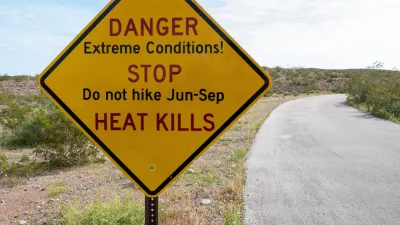Cities can protect residents from extreme heat by enhancing natural and built infrastructure, establishing heat response strategies, and implementing national policies for worker safety and disaster response.

Extreme heat is becoming increasingly common across the United States, with recent records showing the hottest months and years on record. The rising temperatures not only lead to more heat-related deaths but also impose significant economic costs. As Elizabeth Babcock and Michael Shank share in this article, while the long-term solution to this problem involves reducing fossil fuel consumption, there are several immediate actions cities can take to mitigate the impact of extreme heat and protect residents.
One effective approach is enhancing natural and built infrastructure to cool urban environments. Expanding tree canopies, especially in disadvantaged communities, can lower temperatures significantly. Green roofs, reflective cool roofs, and converting community spaces like libraries, recreation centers, and schools into cooling centers are practical measures. Additionally, creating resilience hubs in various community spaces can provide essential services and support year-round, helping residents cope with extreme heat.
Human and policy infrastructure also play crucial roles in mitigating heat impacts. Cities can appoint chief heat officers to coordinate heat response efforts across all departments and develop comprehensive heat strategies. Partnering with community groups to distribute cooling resources and focusing on efficient, low-carbon cooling solutions are essential steps. Nationally, establishing a heat safety standard for workers and creating a disaster declaration capacity for heat at the federal level are necessary to protect public health and ensure a robust response to extreme heat events.
To learn more, please read the source article.
FULL STORY: 4 ways that cities can and should protect their citizens from extreme heat

Maui's Vacation Rental Debate Turns Ugly
Verbal attacks, misinformation campaigns and fistfights plague a high-stakes debate to convert thousands of vacation rentals into long-term housing.

Planetizen Federal Action Tracker
A weekly monitor of how Trump’s orders and actions are impacting planners and planning in America.

In Urban Planning, AI Prompting Could be the New Design Thinking
Creativity has long been key to great urban design. What if we see AI as our new creative partner?

Pedestrian Deaths Drop, Remain Twice as High as in 2009
Fatalities declined by 4 percent in 2024, but the U.S. is still nowhere close to ‘Vision Zero.’

King County Supportive Housing Program Offers Hope for Unhoused Residents
The county is taking a ‘Housing First’ approach that prioritizes getting people into housing, then offering wraparound supportive services.

Researchers Use AI to Get Clearer Picture of US Housing
Analysts are using artificial intelligence to supercharge their research by allowing them to comb through data faster. Though these AI tools can be error prone, they save time and housing researchers are optimistic about the future.
Urban Design for Planners 1: Software Tools
This six-course series explores essential urban design concepts using open source software and equips planners with the tools they need to participate fully in the urban design process.
Planning for Universal Design
Learn the tools for implementing Universal Design in planning regulations.
planning NEXT
Appalachian Highlands Housing Partners
Mpact (founded as Rail~Volution)
City of Camden Redevelopment Agency
City of Astoria
City of Portland
City of Laramie





























